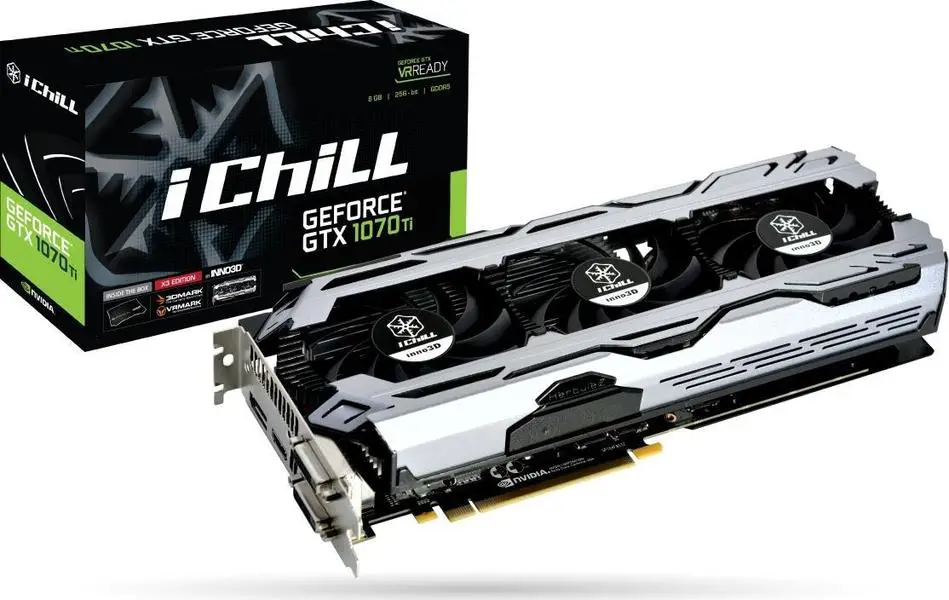Review Inno3D iChill GeForce GTX 1070 Ti X3 Gaming: Benchmark| Memory| Power :Despite the noticeable fluctuations in cryptocurrency rates in recent years, miners do not loosen their grip, so video cards are still in a tight deficit and if they go on sale anywhere, then at exorbitant prices.
It seems that the situation will not change in the next few months, but this does not mean at all that we will postpone reviews and tests of new products on the back burner. On the contrary, in the near future we will introduce you to several interesting models of video cards, both on AMD and NVIDIA GPUs. This winter-spring mini-marathon opens with the Inno3D iChill GeForce GTX 1070 Ti X3 model .
Distinctive features of this model are a reinforced reference printed circuit board, a powerful cooling system and, interestingly, fully rated frequencies of the GPU and video memory. In other words, we can hope for a good overclocking potential of the video card, which should be provided by all of the above components. Whether it will be so, we will find out today. Well, in the test part of the article, we have a couple of new games to compare the performance of video cards.
Review of the video card Inno3D iChill GeForce GTX 1070 Ti X3 8 GB (C107T3-1SDN-P5DN)
technical characteristics and recommended price Technical characteristics and cost of the video card Inno3DiChillGeForceGTX 1070 Ti X3 are shown in the table in comparison with the reference model NVIDIA GeForce GTX 1070 Ti.
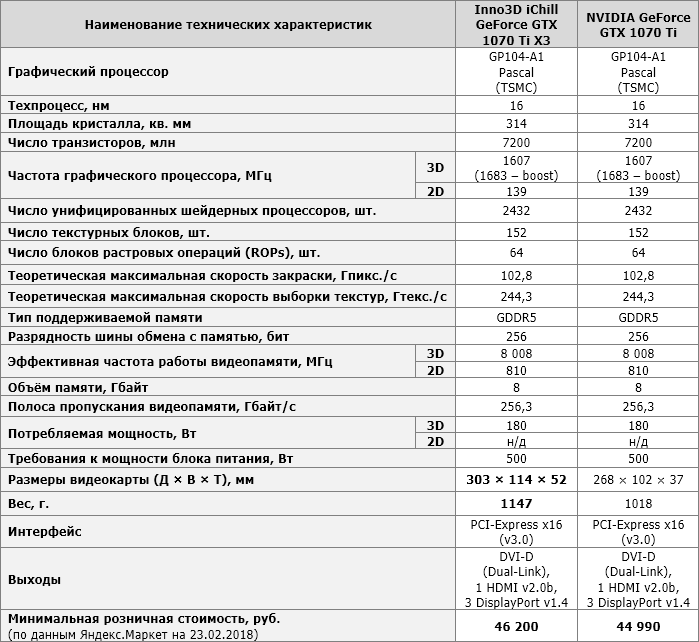
Packaging and Contents A relatively large cardboard box in which the Inno3D iChill GeForce GTX 1070 Ti X3 is sealed, on the front side contains information about the video card model, size, bus and type of video memory, as well as bonuses included in the delivery set.
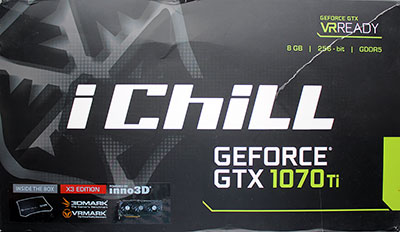
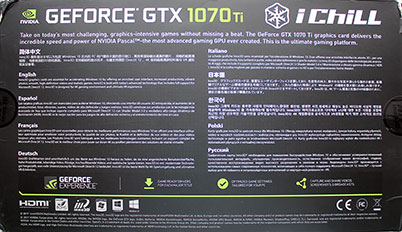
The reverse side of the box is reserved for a description of the advantages of Inno3D video cards in ten languages, including Russian. Inside the colored shell there is an ordinary box made of thick cardboard, in the center of which a video card is fixed in an additional shell made of foamed polyethylene. Thus, we can say that Inno3D has excellent protection against damage. In the delivery set of the video card, the buyer will find a DVD with drivers, two coupons with keys for downloading 3DMark and VRMark benchmarks, as well as a high-quality fabric mouse pad.
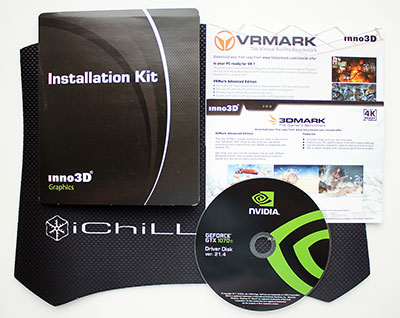
Very good equipment, it should be noted. The country of manufacture of the video card is China, the warranty is three years. As of the end of February 2018, Inno3DiChillGeForceGTX 1070 TiX3 can be purchased in Russian stores for at least 46 thousand rubles, and it costs the same in foreign stores. Unfortunately, these prices are still very far from the recommended ones by NVIDIA ($ 449). However, today this applies not only to the GeForce GTX 1070 Ti, but also to the vast majority of modern video cards. PCB design and features
The design of the Inno3D iChill series graphics cards has not changed for a long time, so they are easily recognizable externally. So the GeForce GTX 1070 Ti X3 is no exception, and is a massive video card, completely closed on all sides by a cooling system and a decorative plate. Only connectors, outputs and connectors are visible, nothing else.
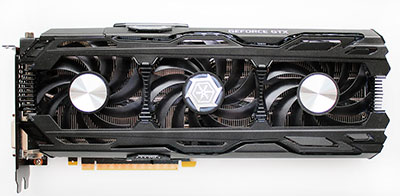
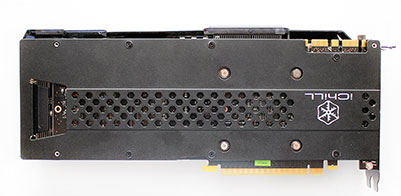
On top of the casing there is a plastic insert with a backlit logo, and on the bottom there are longitudinal slots for the passage of heated air from the radiator.
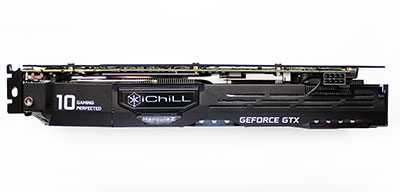
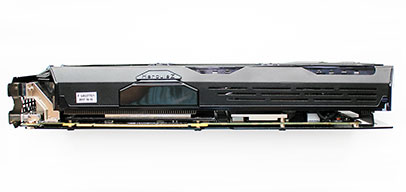
The video card is 303 mm long, 114 mm high and 51 mm thick. When installing Inno3D iChill GeForce GTX 1070 Ti X3 into the motherboard, one and a half adjacent PCI-E slots will be blocked. The weight of the Inno3D iChill GeForce GTX 1070 Ti X3 is 1147 grams.
From the end of the video card opposite to the video outputs, you can see a massive aluminum radiator and four heat pipes.
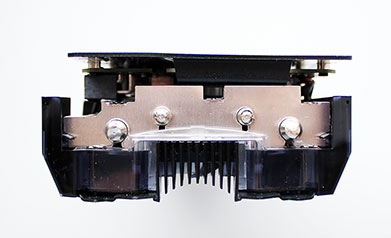
Interestingly, from this perspective it is clear that the cooling system is installed not parallel to the PCB, but with a slight slope. However, perhaps this is just a feature of our video card instance.
The Inno3D iChill GeForce GTX 1070 Ti X3 features one DVI-D video output, one HDMI 2.0b and three DisplayPorts 1.4.
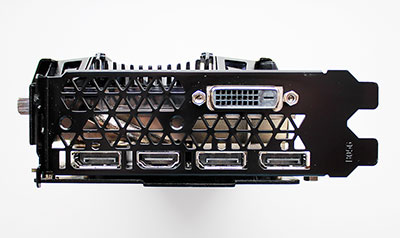
The rest of the area on this panel is perforated with triangular holes to minimize resistance to air outflow from the cooling system. By the way, despite the orientation of the fans on the video card, the air flow comes out quite noticeable here.
In terms of other connectors, everything is standard on the Inno3D iChill GeForce GTX 1070 Ti X3. On top there are two connectors for SLI, and on the opposite end of the PCB there is an eight-pin connector for additional power, oriented with a latch inward, which is not very convenient when disconnecting the cable.
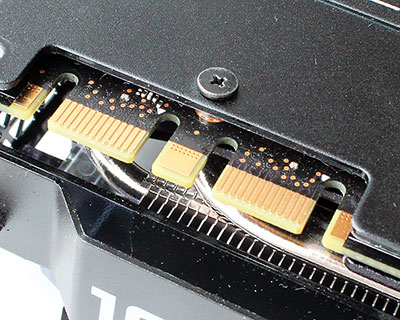
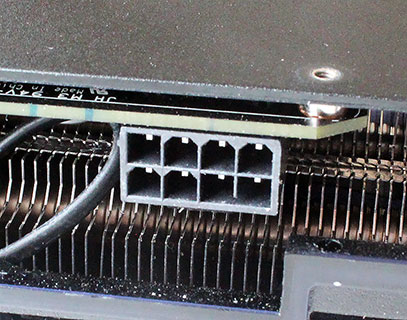
Since the video card has completely standard frequencies, Inno3D did not deviate from NVIDIA’s recommendations, and in the specifications for the Inno3D iChill GeForce GTX 1070 Ti X3 they indicated the power consumption level in 3D mode of 180 watts. The power supply for a system with one such video card must be at least 500 watts.
The cooling system of the video card is fixed to the PCB with four screws around the perimeter of the GPU and two more in the area of the VRM elements.
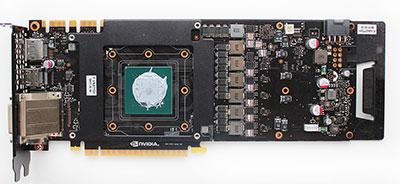
After removing the cooler, it is necessary to unscrew the plate with the video memory chips and the rear protective and decorative plate. Only after that the textolite of the video card becomes completely open. The Inno3D iChill GeForce GTX 1070 Ti X3 is based on an NVIDIA reference PCB, but unlike the reference GeForce GTX 1070 Ti models , there are no missing GPU power phases or empty capacitor slots. All elements are in place.
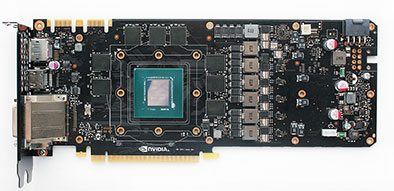
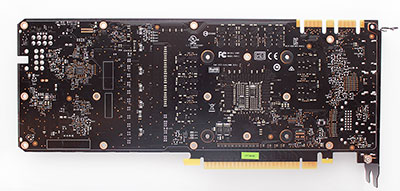
In total, six phases are allocated to power the GPU, and another one is responsible for memory and power circuits.
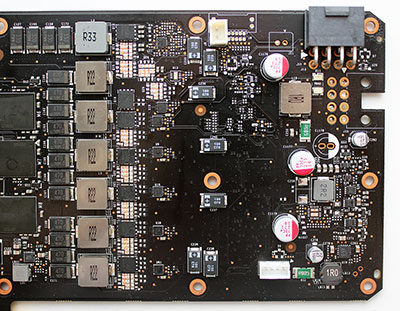
On the reverse side of the PCB in the GPU area, four solid-state capacitors with a capacity of 330 uF each are soldered.
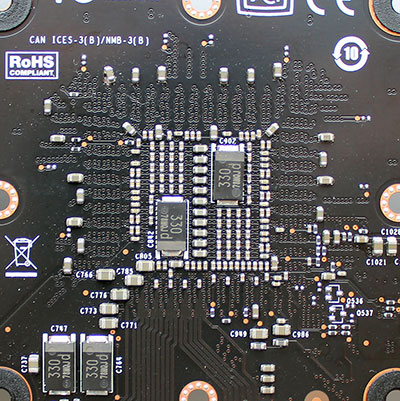
Power Management GPU installed vosmifazny Controller up9511P production uPI Group.
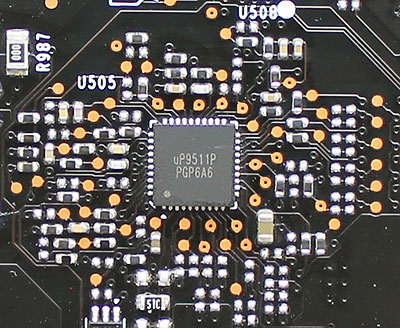
The substrate of the graphics processor of the video card does not have a protective frame around the perimeter, therefore, when installing or removing the cooler, you should be extremely careful not to chip off the fragile GPU crystal. Our copy of the video card was released on the 34th week of 2017 (end of August) and belongs to revision A1.
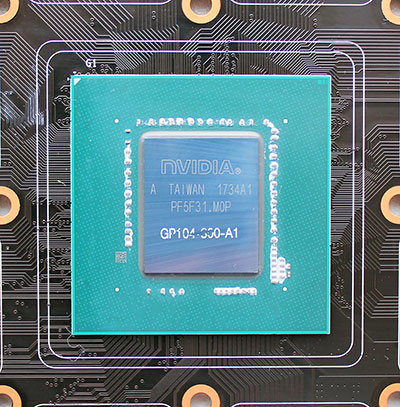
The GPU contains 2,432 universal shader processors, 152 texture units, and 64 ROPs. Its base frequency on the Inno3D iChill GeForce GTX 1070 Ti X3 in 3D mode is 1607 MHz, and in the boosted mode it should increase to 1683 MHz. However, in fact, the frequency of the GPU of the video card was increased much higher, which we will discuss below. Note that there is no factory overclocking here and that when switching to 2D mode, the processor frequency decreases to 139 MHz simultaneously with a voltage drop from 1.050 V to 0.875 V, which may differ on each video card. The Inno3D iChill GeForce GTX 1070 Ti X3 has a standard eight gigabytes of GDDR5 memory packed with Micron chips marked 7QA47 D9TCB and a theoretical effective frequency of 8 GHz.
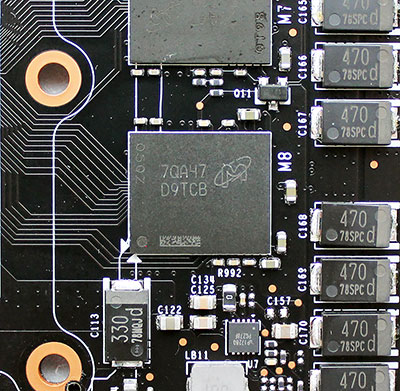
It is at this frequency that the memory of the video card functions, providing a bandwidth of up to 256.3 GB / s with a 256-bit bus width. In 2D mode, the memory frequency is reduced to 810 MHz.
At the end of this subsection of the article, we present the characteristics of the Inno3D video card from the GPU-Z utility.
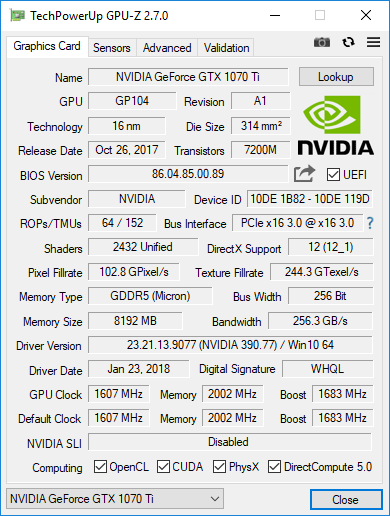
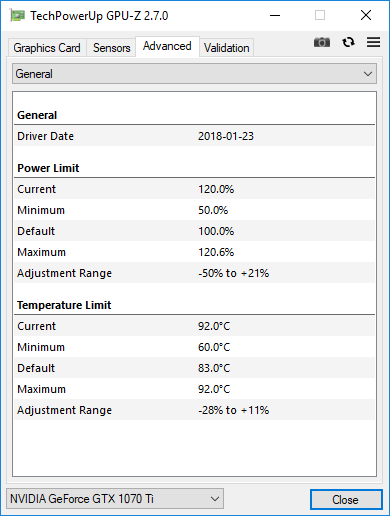
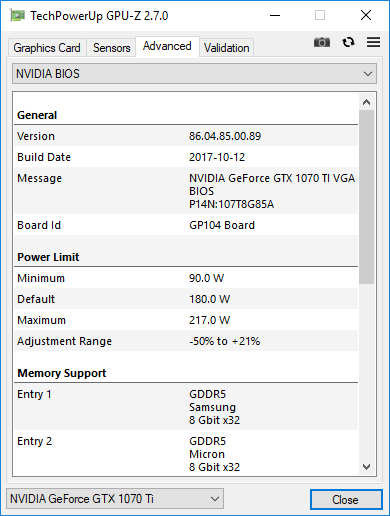
In addition, we publish the video card BIOS that enthusiasts can experiment with as they please.
cooling system The Inno3D iChill GeForce GTX 1070 Ti X3 graphics card is equipped with a massive cooling system, which includes a two-piece radiator on heat pipes, a platform for cooling VRM elements and a shroud with three fans.
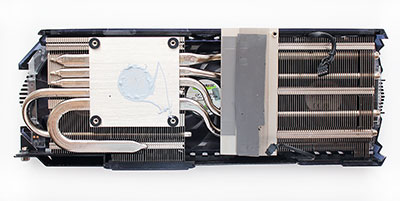
This cooler occupies 2.5 slots in thickness.
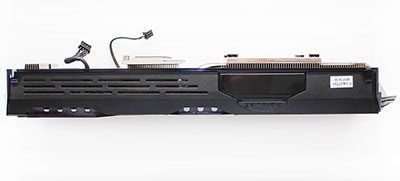
Both radiator sections are nickel plated. In total, they have five copper heat pipes: two with a diameter of 6 mm, one with a diameter of 8 mm and two more 10 mm.
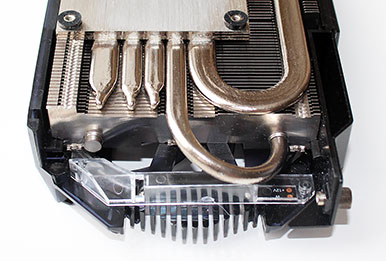
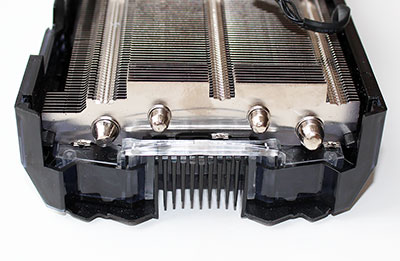
How the tubes pass in the radiator sections can be clearly seen in the photo. We will add that all the pipe and edge mating points are soldered.
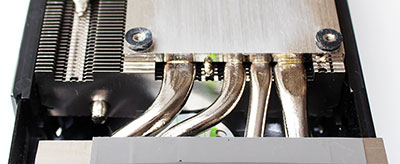
The quality of processing of the contact surface of the cooler base leaves much to be desired, traces of processing are not only visible to the naked eye, but also felt tactilely. However, the worst impression was left by the excessive amount of thermal paste on the GPU. He was literally splattered all over with her.
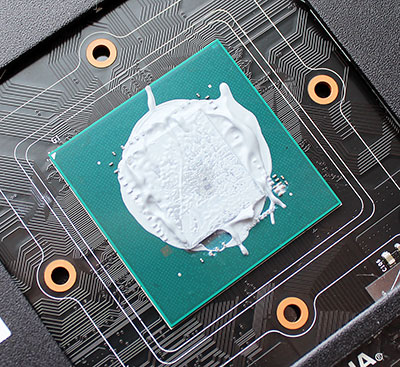

If the previous video card tester tried so hard, then this is one thing, but if this is a factory approach, then I would like to draw the attention of Inno3D to this fact. With so many thermal interfaces on the die, the GPU will definitely not cool better.
The VRM circuit elements are cooled by a plate soldered to the large section of the heatsink and in contact with them through thermal spacers. In turn, a 2-mm plate with thermal spacers is provided for cooling the video memory chips.
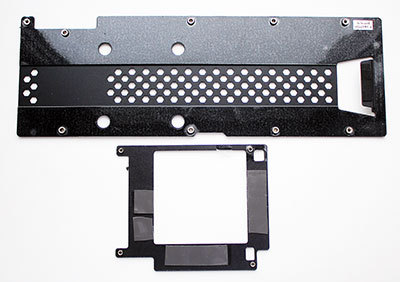
The back plate on the PCB, made of metal, performs a decorative and protective function, and does not participate in the heat exchange process, although it is perforated.
The video card is cooled by three fans with an impeller diameter of 85 mm. Judging by the markings on the stator, they are produced by Colorful and have a power of 4.2 watts each.
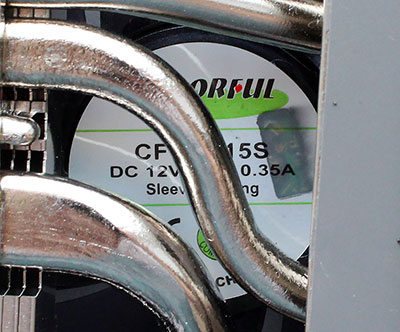
Their rotation speed is automatically controlled by pulse width modulation (PWM) and, according to monitoring data, varies in the range from 0 to ~ 1710 rpm. In 2D mode, the fans stop, which we do not welcome and have already explained our position in one of the previous articles .
On top of the plastic casing of the cooler, there is a small panel with the logo and the name of a series of video cards.
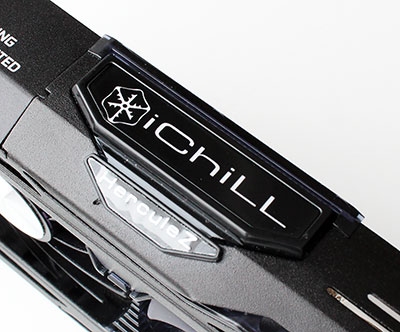
It is not only highlighted, but also changes color depending on the load.

In addition, white LEDs are built into the shroud near the fans, so the video card looks very attractive during operation, especially at night.
We used nineteen cycles of the Fire StrikeExtreme stress test from the 3DMark graphics package to test the temperature regime of the video card as a load.
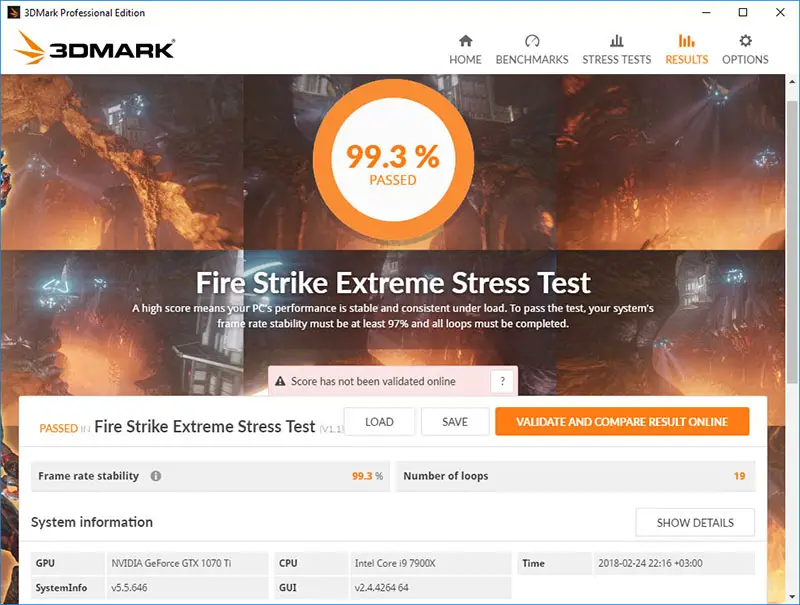
To monitor temperatures and all other parameters, we used MSI Afterburner version 4.4.2 and GPU-Z utility version 2.7.0. The tests were carried out in a closed case of the system unit, the configuration of which you can see in the next section of the article, at a room temperature of about 24 degrees Celsius.
First of all, we tested the cooling efficiency of the Inno3D iChill GeForce GTX 1070 Ti X3 in automatic fan mode.
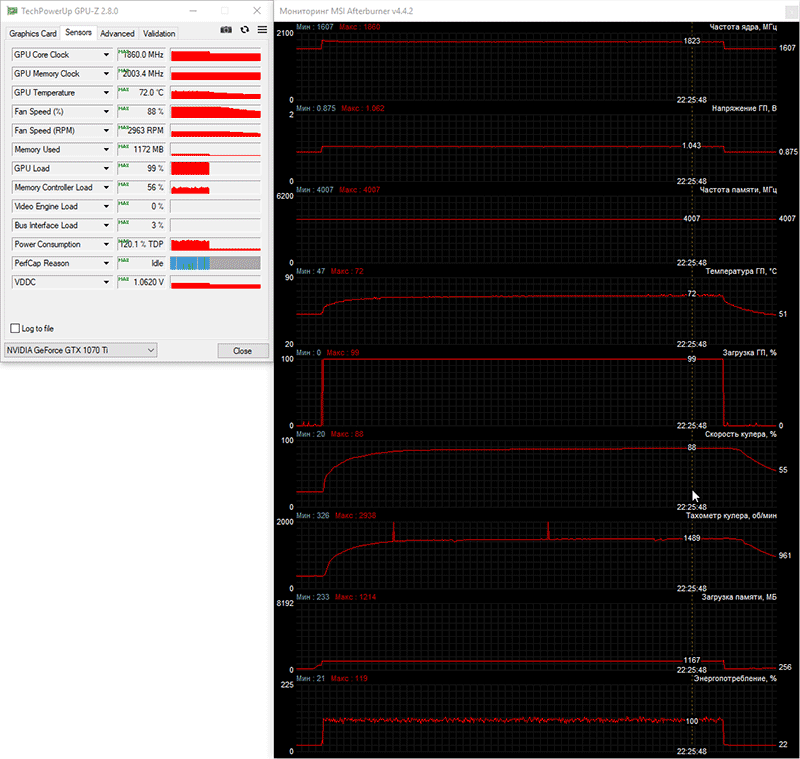
Automatic mode (0-1490 rpm)
The graphics processor of the video card warmed up to 72 degrees Celsius at the peak of the load, and the fan speed reached 1490 rpm. To be honest, we expected somewhat more impressive efficiency from such a massive and technologically advanced cooling system, but, most likely, we simply have too high requirements, especially since the frequency of the graphics processor of the video card increased to 1860 MHz and then stabilized at 1823 MHz, which is much higher declared in the specifications.
At the maximum fan speed, which turned out to be only 220 rpm higher than the automatic one, the temperature of the GPU dropped by 5 degrees Celsius.
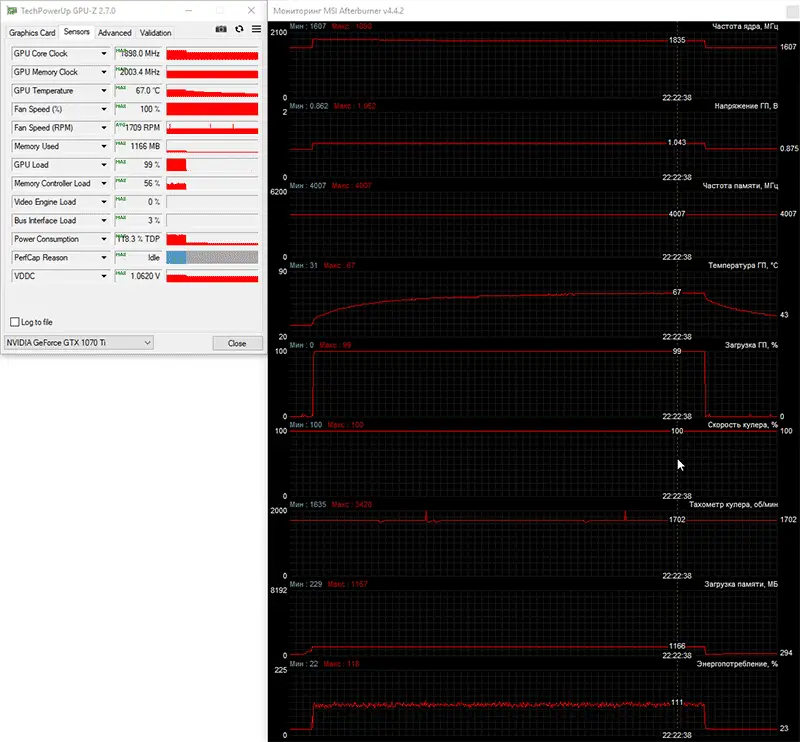
Maximum speed (1710 rpm)
Now let’s check how the video card makes noise in these modes and how its noise level compares with other video cards.
The measurement of the noise level of the video card cooling systems was carried out by an electronic sound level meter “OCTAVA-110A” after 1 am in a completely closed room with an area of about 20 m² with double-glazed windows. The noise level was measured outside the case of the system unit, when the source of noise in the room was exclusively the cooling system of the video card and its fans. The sound level meter, fixed on a tripod, was always located exactly at one point at a distance of exactly 150 mm from the fan / turbine rotor of the cooler. The motherboard, into which a video card with a cooling system installed on it was inserted, was placed at the very corner of the table on a polyurethane foam substrate. The lower limit of the sound level meter measurements is 22 dBA, and the subjectively comfortable (please do not confuse with low) noise level when measuring from such a distance is about 36 dBA.
In the graph with the noise level of the Inno3D iChill GeForce GTX 1070 Ti X3 cooler, we included the results of measurements of the noise level of the cooling systems of two previously tested Inno3D video cards: Inno3D iChill GeForce GTX 1070 Ti X4 and Inno3D GeForce GTX 1070 HerculeZ Twin X2 , as well as Gigabyte GeForce GTX 1080 G1 Gaming . Let us add that the vertical dotted lines of the corresponding color mark the upper limits of the speed of the cooling system fans during their automatic PWM control.
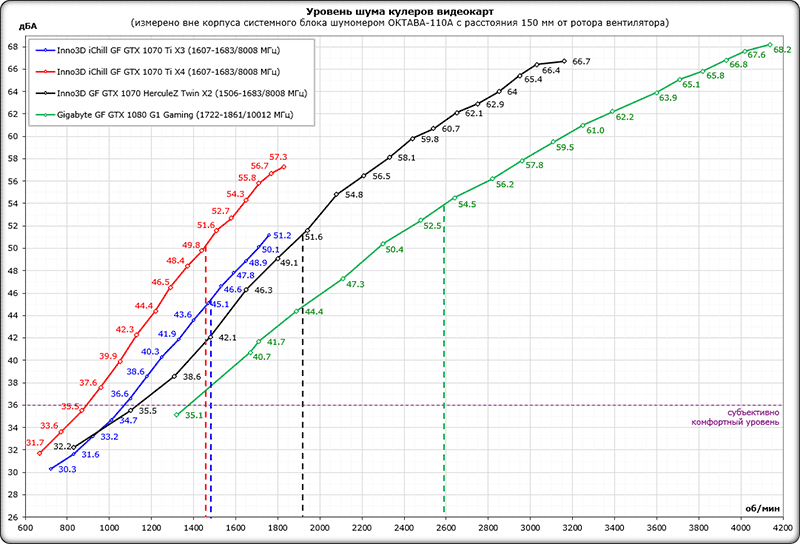
Inno3D iChill GeForce GTX 1070 Ti X3 turned out to be the quietest video card of the four, but still not quiet in absolute terms, because at fan speeds above 1100 rpm, its cooling system becomes audible. Nevertheless, all other things being equal, the version of Inno3D with an X3 cooler with automatic fan speed control is noticeably quieter than almost the same cooler with the letters X4 and even quieter than another cooling system from this company – HerculeZ Twin X2, and installed on a less hot model …
Well, since we found out at what fan speed the video card becomes comfortable in terms of noise level, then let’s manually limit this speed and see if the massive cooling system can cope with the hot temper of the video card? To do this, we fixed the fan speed at 1100 rpm and ran the 3DMark stability test using our method again.
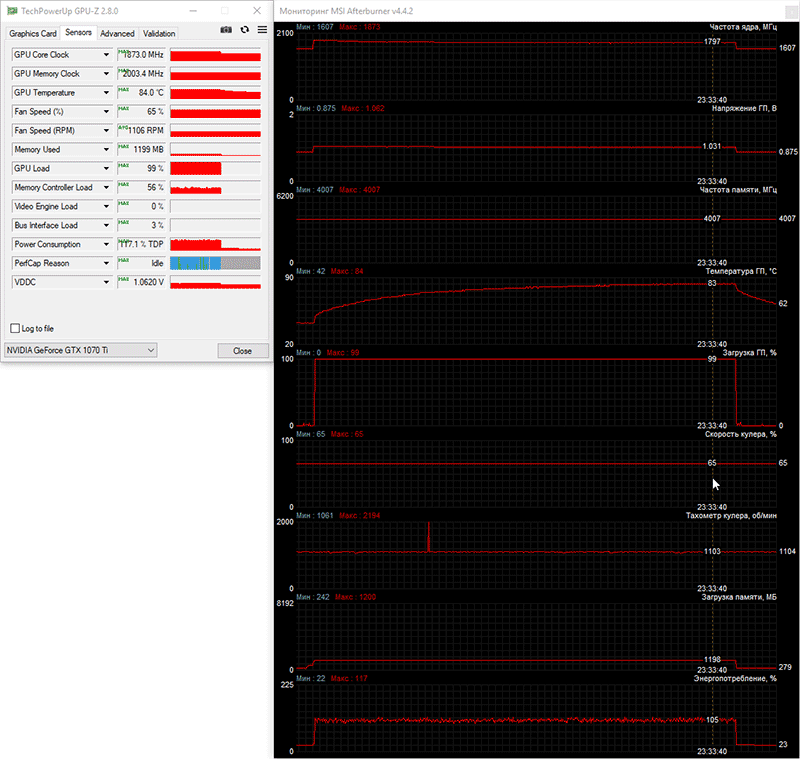
In comparison with the automatic mode of adjusting the fan speed, the temperature immediately increased by 12 degrees Celsius at the peak of the load, but was still far from critical (90 degrees Celsius in the BIOS). Even though the frequency of the GPU was kept at a more modest level, the cooler still coped with the cooling of the video card. It turns out that, if necessary, from the Inno3D iChill GeForce GTX 1070 Ti X3, you can get a video card that is quite comfortable in terms of noise level and at the same time not worry about its temperature regime (with well-organized ventilation inside the case of the system unit, of course).
Overclocking potential
Since the Inno3D iChill GeForce GTX 1070 Ti X3 has no factory overclocking, we could count on good overclocking potential, coupled with a reinforced PCB and an efficient cooler. In principle, this is what happened, since we overclocked the graphics processor by 130 MHz from the base frequency or + 8.1%, and increased the effective video memory frequency by 930 MHz or + 11.6%.
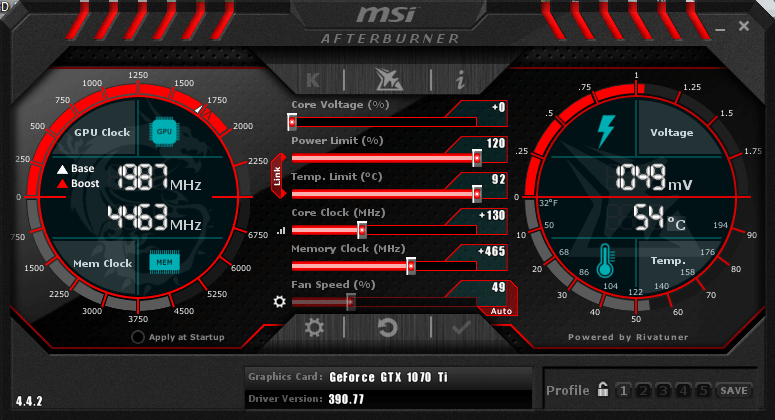
As a result, the frequencies of the overclocked video card were 1737-1813 / 8940 MHz.
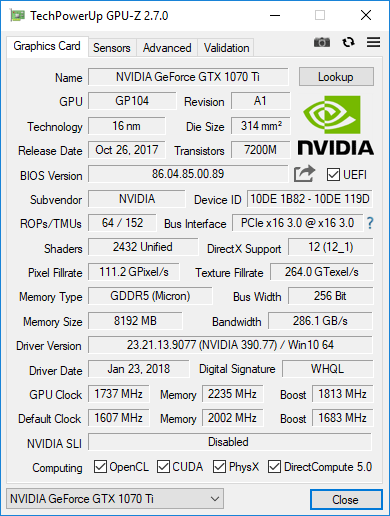
Moreover, the peak frequency of the graphics processor after overclocking the video card reached 1974 MHz, and during testing it more or less stabilized at around 1936 MHz. In comparison with the nominal operating mode of the video card, its temperatures have increased by only 3 degrees Celsius, while the peak for the GPU is 75 degrees Celsius.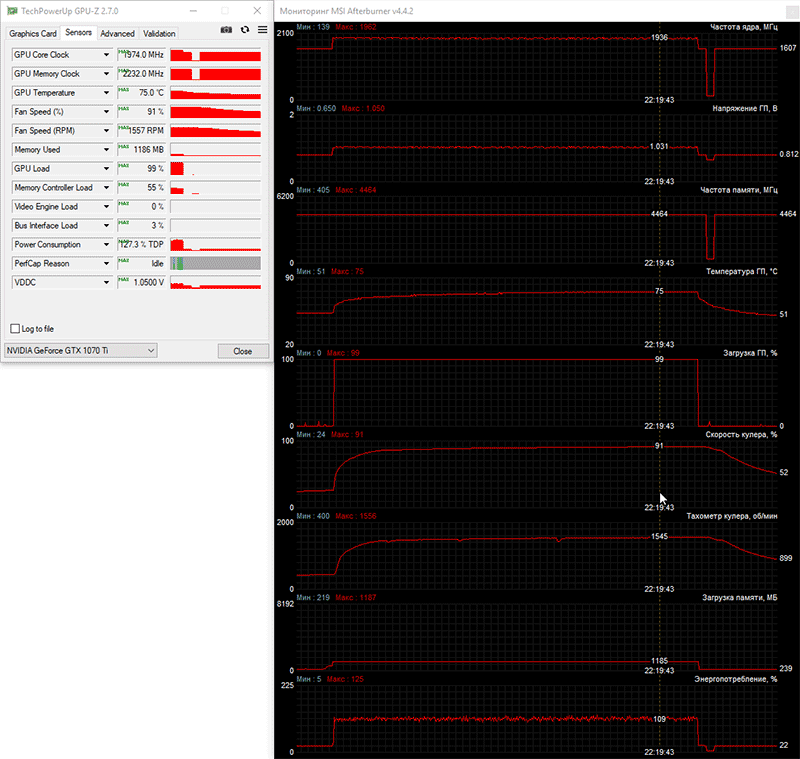
Automatic mode (400-1560 rpm)
At the same time, the maximum fan speed has also slightly increased – from 1490 to 1560 rpm, but this has the least effect on the noise level.
Test configuration, tools and testing methodology
The video cards were tested in a closed system case on the following hardware configuration: motherboard: ASUS ROG Strix X299-E Gaming (Intel X299 Express, LGA2066, BIOS 1102 dated 01/17/2018); central processor: Intel Core i9-7900X (14 ++ nm, Skylake-X, U0, 3.3-4.5 GHz, 1.1 V, 10 × 1 MB L2, 13.75 MB L3); CPU cooling system: Phanteks PH-TC14PЕ (2 × Corsair AF140, 780 ~ 1090 rpm); thermal interface: ARCTIC MX-4 (8.5 W / (m * K); RAM: DDR4 4 × 4 GB Corsair Vengeance LPX 2800 MHz (CMK16GX4M4A2800C16) (XMP 2800 MHz / 16-18-18-36_2T / 1.2 V or 3000 MHz / 16-18-18-36_2T / 1.35 V); video cards: Gigabyte GeForce GTX 1080 G1 Gaming 8 GB / 256 bit 1696-1835 (1936) / 10008 MHz;
Inno3D iChill GeForce GTX 1070 Ti X3 8 GB / 256 bit 1607-1683 (1823) / 8008 MHz and overclocked to 1737-1813 (1936) / 8940 MHz;
Inno3D GeForce GTX 1070 HerculeZ Twin X2 8 GB / 256 bit 1506-1683 (1860) / 8008 MHz;
disk for system and games: Intel SSD 730 480 GB (SATA III, BIOS vL2010400);
benchmark disk: Western Digital VelociRaptor 300 GB (SATA II, 10,000 rpm, 16 MB, NCQ);
archive disk: Samsung Ecogreen F4 HD204UI 2 TB (SATA II, 5400 rpm, 32 MB, NCQ);
sound card: Auzen X-Fi HomeTheater HD;
case: Thermaltake Core X71 (five be quiet! Silent Wings 2 (BL063) at 900 rpm);
control and monitoring panel: Zalman ZM-MFC3;
PSU: Corsair AX1500i Digital ATX (1500 W, 80 Plus Titanium), 140 mm fan;
monitor: 27-inch Samsung S27A850D (DisplayPort, 2560 × 1440, 60 Hz). The performance of the Inno3D iChill GeForce GTX 1070 Ti X3 is comparable to the Gigabyte GeForce GTX 1080 G1 Gaming and the Inno3D GeForce GTX 1070 HerculeZ Twin X2 at their rated clocks.
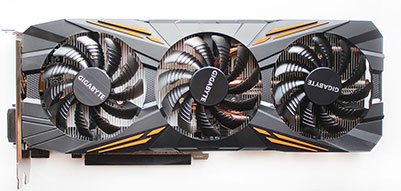
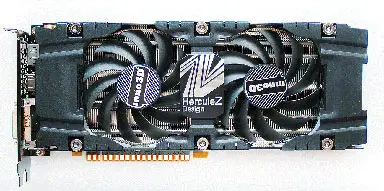
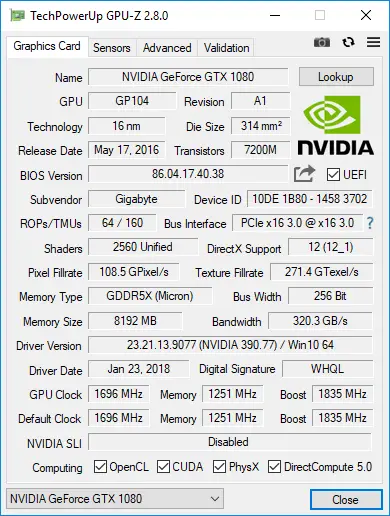
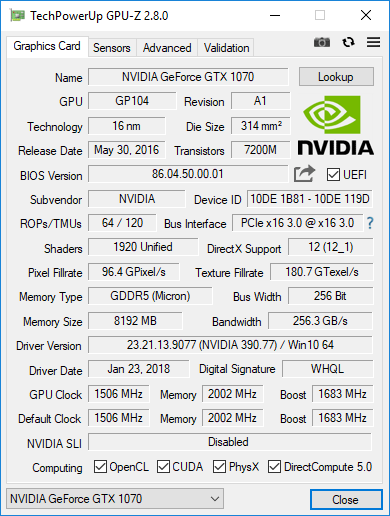
The power and temperature limits on video cards were increased to the maximum possible, and the GeForce drivers were prioritized for maximum performance. As for the competitors on AMD graphics processors, they, of course, are not enough in this test, but it is almost impossible to get them for testing, even despite the fact that the Radeon RX Vega 64 was released more than six months ago. To reduce the dependence of the performance of video cards on the platform speed, a 14-nm ten-core processor with a multiplier of 44, a reference frequency of 100 MHz and the Load-Line Calibration function activated to the fourth level was overclocked to 4.4 GHz when the voltage in the motherboard BIOS was increased to 1.120 V.
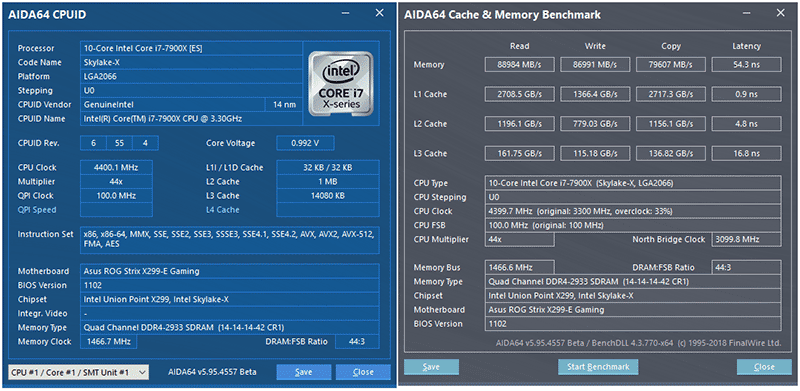
At the same time, 16 gigabytes of RAM functioned in a four-channel mode at a frequency of 2.933 GHz with timings 14-14-14-26_CR1 at a voltage of 1.35 V. Testing, which began on January 20, 2018, was carried out under the control of the Microsoft Windows 10 Pro operating system (1709 16299.19) with all updates as of the specified date and with the installation of the following drivers: motherboard chipset Intel Chipset Drivers – 10.1.17541.8066 WHQL dated 01/10/2018 ; Intel Management Engine Interface (MEI) – 11.7.0.1065 WHQL from 01/08/2018; drivers for video cards on NVIDIA GPUs – GeForce 390.77 WHQL from 01/29/2018.
In today’s testing, we used only 2560 × 1440 pixels, which is the most optimal for video cards of this class. Two graphics quality modes were used for the tests: Quality + AF16x – texture quality in the drivers by default with anisotropic filtering at 16x and Quality + AF16x + MSAA 4x / 8x with anisotropic filtering at 16x and full-screen anti-aliasing at 4x or 8x. In some games, due to the specifics of their game engines, other anti-aliasing algorithms were used, which will be indicated later in the methodology and directly on the diagrams with the results. Anisotropic filtering and full-screen anti-aliasing was enabled in the game settings. If these settings were absent in games, then the parameters were changed in the control panel of the GeForce drivers. V-Sync was also forcibly disabled there. Apart from the above, no additional changes were made to the driver settings.
The video cards have been tested in two graphics tests and fifteen games, updated to the latest versions as of the date of the publication. If we compare our test set with the previous article , then, in addition to the traditional update of the games already present in the list, three new games were included at once: Assassin’s Creed: Origins, Call of Duty: WWII and the World of Tanks enCore benchmark. So, now the list of test applications looks like this (games and further test results in them are arranged in the order of their official release): 3DMark (DirectX 9/11/12) – version 2.4.4264, testing in scenes FireStrike, FireStrike Extreme, FireStrike Ultra and TimeSpy (the diagram shows a graphical score);
Unigine Superposition (DirectX 11) – version 1.0, tested in 1080P High, 1080P Extreme and 4KOptimized settings;
Metro: LastLight (DirectX 11) – version 1.0.0.15, the built-in game test was used, graphics quality settings and tessellation at the Very High level, Advanced PhysX technology is activated, tests with SSAA and without anti-aliasing, double sequential run of the D6 scene;
Grand Theft Auto V (DirectX 11) – build 1290.0, quality settings at Very High, ignoring suggested restrictions enabled, V-Sync disabled, FXAA enabled, NVIDIA TXAA disabled, MSAA for reflections disabled, NVIDIA soft shadows;
TomClancy’s Rainbow Six: Siege (DirectX 11) – version 2.2.2, texture quality settings at the Very High level, TextureFiltering – Anisotropic 16X and other maximum quality settings, tests with MSAA 4x and without anti-aliasing, double sequential run of the test built into the game;
Rise of the Tomb Raider (DirectX 12) – version 1.0 build 813.4_64, all parameters at the Very High level, Dynamic Foliage – High, Ambient Occlusion – HBAO +, tessellation and other quality improvement techniques are activated, two test cycles of the built-in benchmark (Geothermal scene Valley) without anti-aliasing and with SSAA 4.0 activation;
Far Cry Primal (DirectX 11) – version 1.3.3, maximum quality level, high-resolution textures, volumetric fog and shadows to maximum, built-in performance test without anti-aliasing and with SMAA Ultra enabled;
Hitman (DirectX 12) – version 1.13.2, built-in test with graphics quality settings at the “Ultra” level, SSAO enabled, shadow quality “Ultra”, memory protection disabled;
DeusEx: Mankind Divided (DirectX 12) – version 1.19 build 801.0, all quality settings are manually set to the maximum level, tessellation and depth of field are activated, at least two consecutive runs of the benchmark built into the game;
For Honor (DirectX 11) – version 32.199, maximum graphics quality settings, volumetric lighting – MHBAO, dynamic reflections and blur effect enabled, anti-aliasing oversampling disabled, tests without anti-aliasing and with TAA, double sequential run of the benchmark built into the game;
Tom Clancy’s Ghost Recon Wildlands (DirectX 12) – version 1.6.0, graphics quality settings to maximum or Ultra-level, all options are activated, tests without anti-aliasing and with SMAA + FXAA, double sequential run of the benchmark built into the game;
Warhammer 40,000: Dawn of War III (DirectX 11) – version 4.321.3939.18334, all graphics quality settings to the maximum level, anti-aliasing is activated, but in AA mode, resolution scaling up to 150% was used, a double sequential run of the benchmark built into the game;
F1 2017 (DirectX 11) – version 1.7, the built-in game test was used on the Marina Bay track in Singapore during a rainstorm, graphics quality settings were set to the maximum level for all points, SSRT shadows were activated, tests with TAA and without anti-aliasing;
Middle-earth: Shadow of War (DirectX 11.1) – version 1.05, all graphics quality settings to Ultra, depth of field and tessellation activated, double sequential run of the test built into the game without anti-aliasing and with TAA;
Assassin’s Creed: Origins (DirectX 11) – version 1.21, the built-in game benchmark was used with the Ultra High settings profile and dynamic resolution disabled, double test run without anti-aliasing and with anti-aliasing at the High level;
Call of Duty: WWII (DirectX 11) – version 1.11, all graphics quality settings are at the extra level, shadows are enabled, testing without anti-aliasing and when the SMAA T2X option is activated, a double run of the opening scene of the first stage of D-Day was used, FRAPS 105 seconds;
World of Tanks enCore (DirectX 11) – version 0.1, graphics quality settings profile – Ultra, resolution 2560 × 1440 pixels, double sequential run of the test built into the game without anti-aliasing and with TSSAA HQ activation. Let’s add that if the games have implemented the ability to fix the minimum number of frames per second, then it was also shown in the diagrams. Each test was carried out twice, the best of the two obtained values was taken as the final result, but only if the difference between them did not exceed 1%. If the deviations of the benchmark runs exceeded 1%, then the testing was repeated at least one more time to get a reliable result.
Performance test results
3DMark
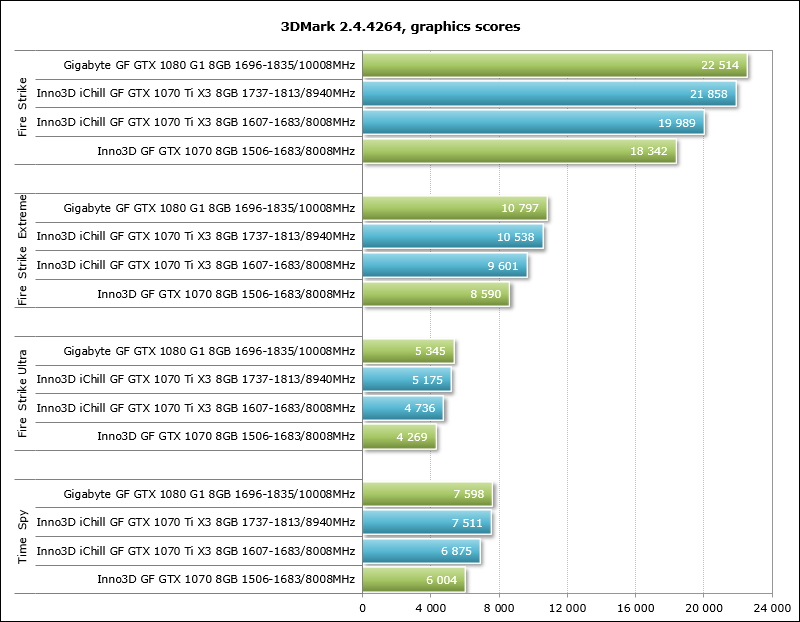
Unigine Superposition
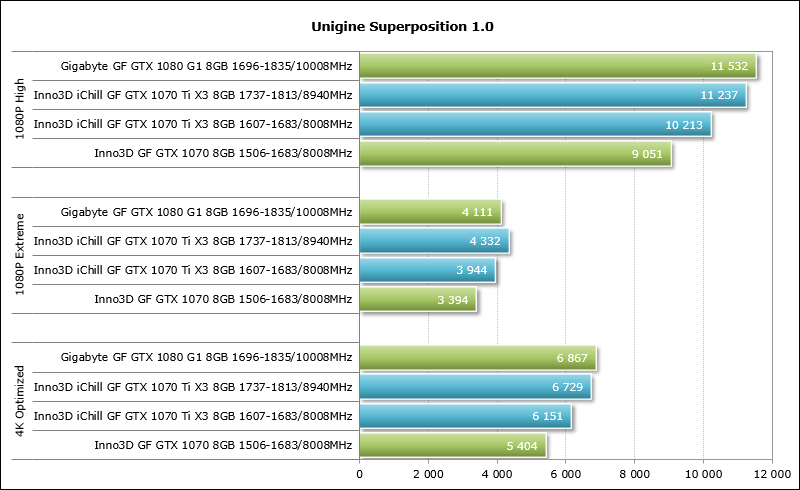
Metro: LastLight
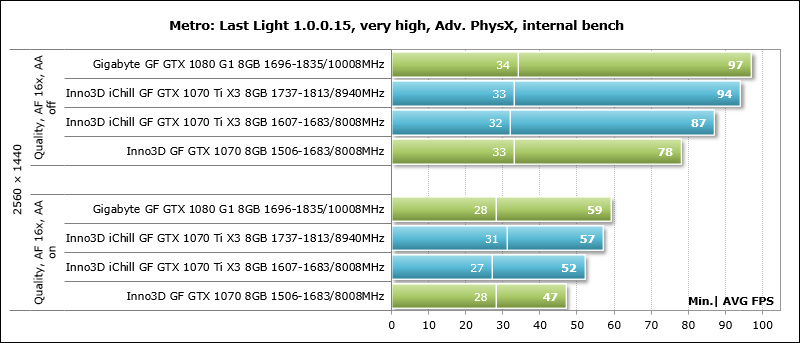
Grand Theft Auto V
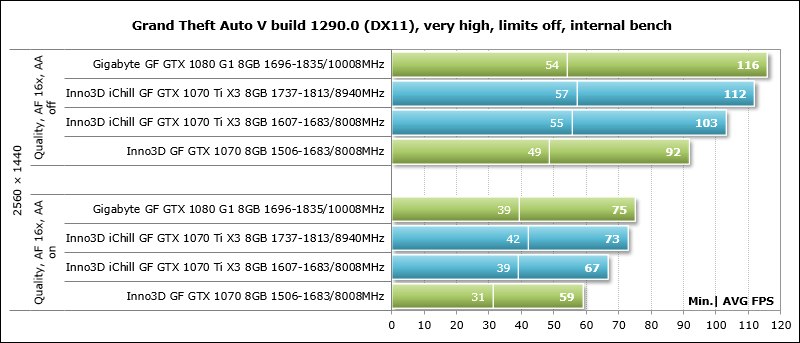
Tom Clancy’s Rainbow Six: Siege
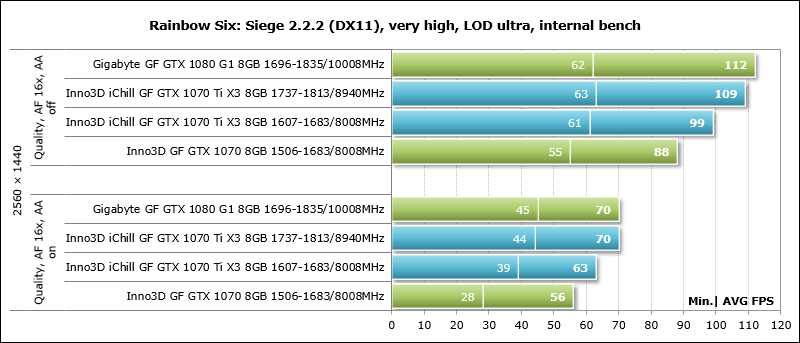
Rise of the Tomb Raider
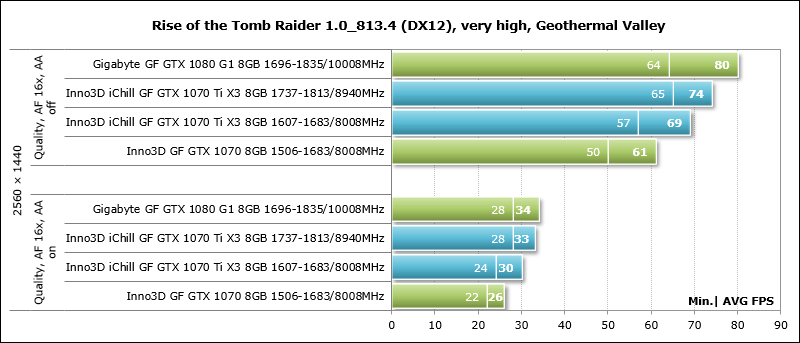
Far Cry Primal
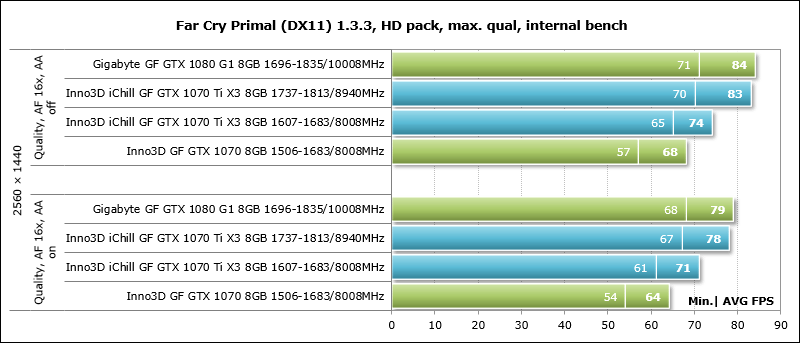
Hitman
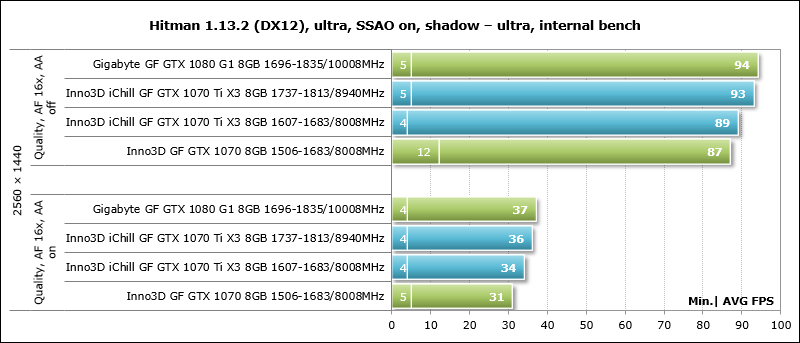
Deus Ex: Mankind Divided
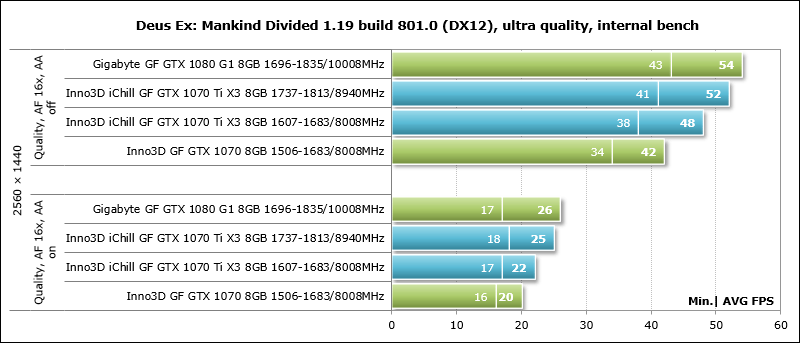
For Honor
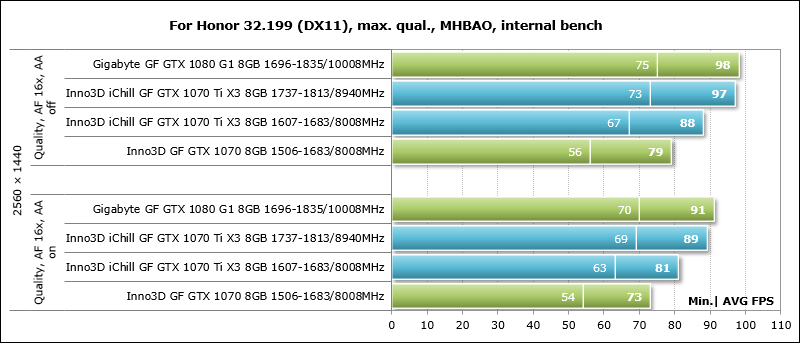
Tom Clancy’s Ghost Recon Wildlands
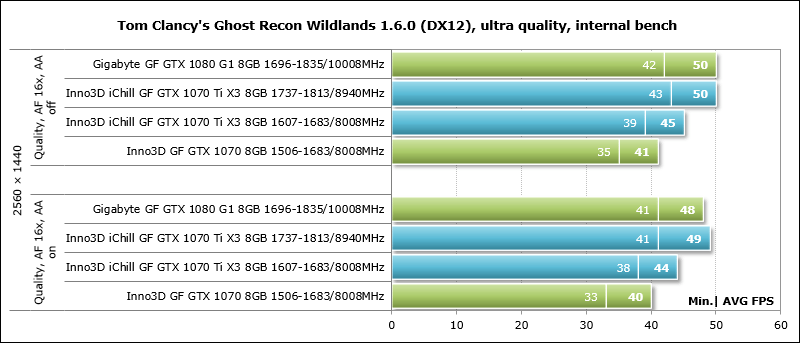
Warhammer 40,000: Dawn of War III
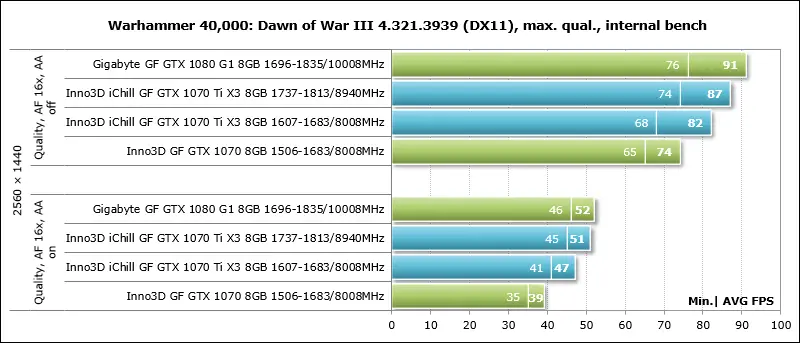
F1 2017
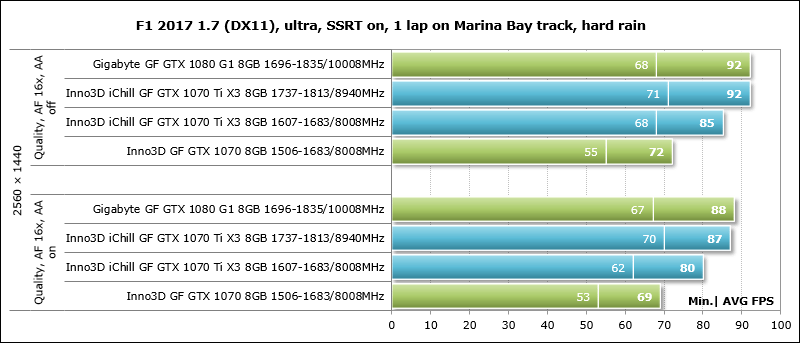
Middle-earth: Shadow of War
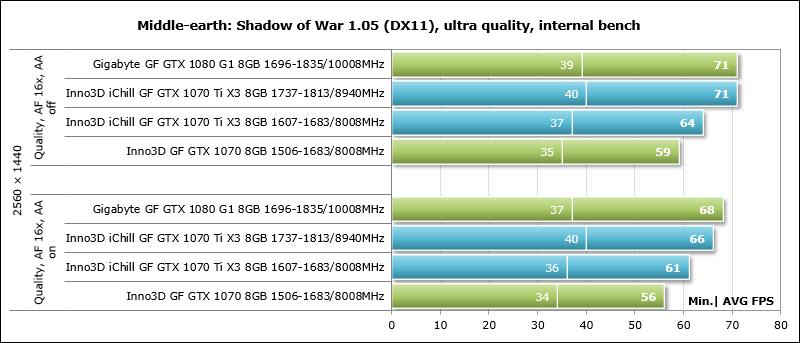
Assassin’s Creed: Origins Since we are testing for the first time in Assassin’s Creed: Origins , we will first give screenshots with the graphics quality settings in the game, which will be used in this and subsequent articles.
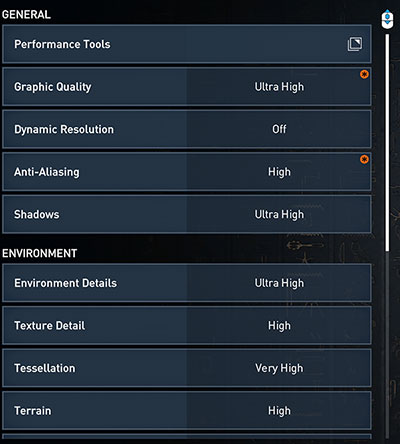

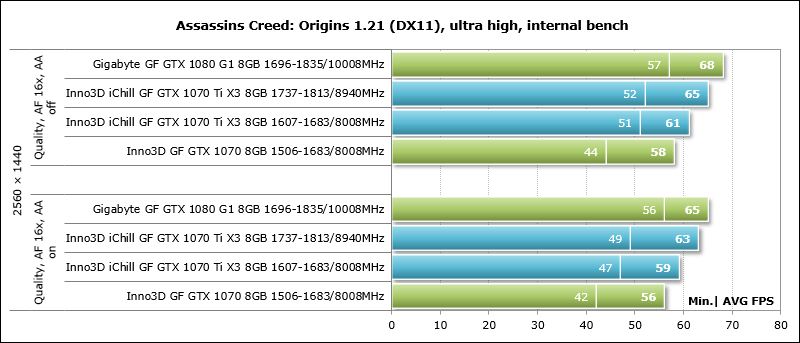
Call of Duty: WWII We also present the graphics quality settings in the Call of Duty: WWII game.
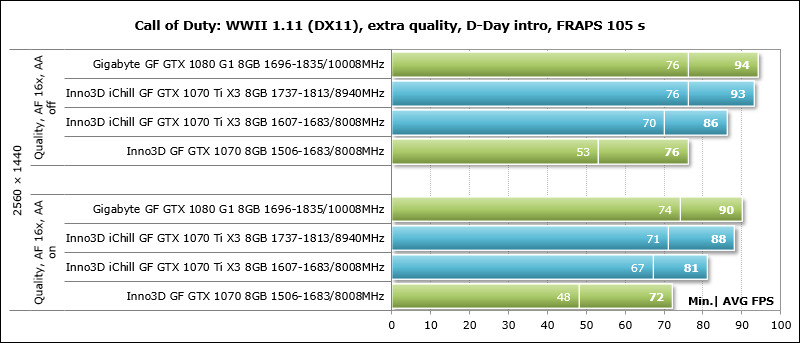
World of Tanks enCore
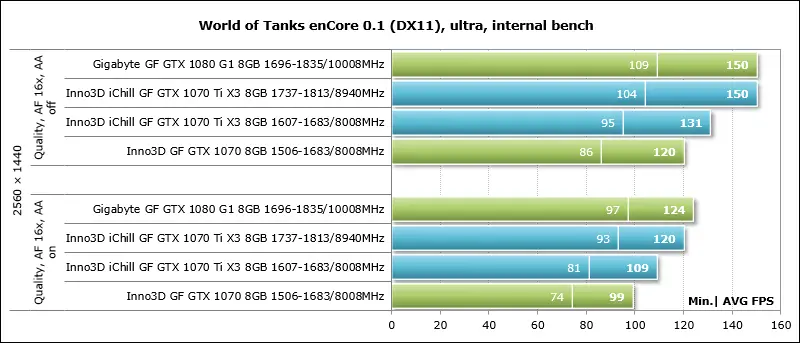
Let’s supplement the constructed diagrams with a summary table with test results with the displayed average and minimum value of the number of frames per second for each video card.
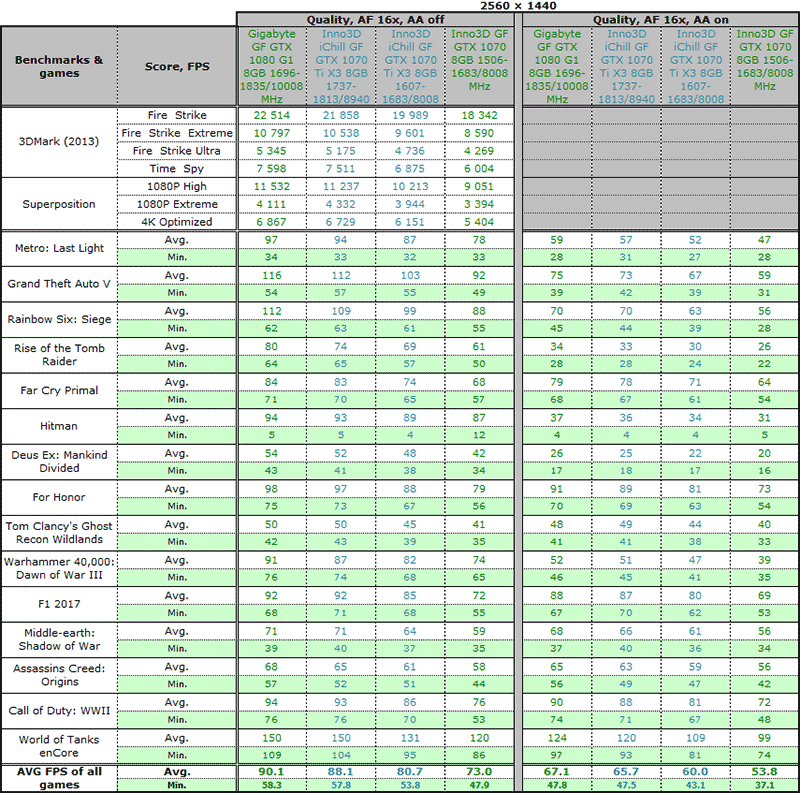
We will analyze the results using summary diagrams.
Pivot charts and analysis of results
In the first pivot diagram, we will evaluate the advantage of the Inno3D iChill GeForce GTX 1070 Ti X3 over the Inno3D GeForce GTX 1070 HerculeZ Twin X2 at the nominal frequencies of both video cards.
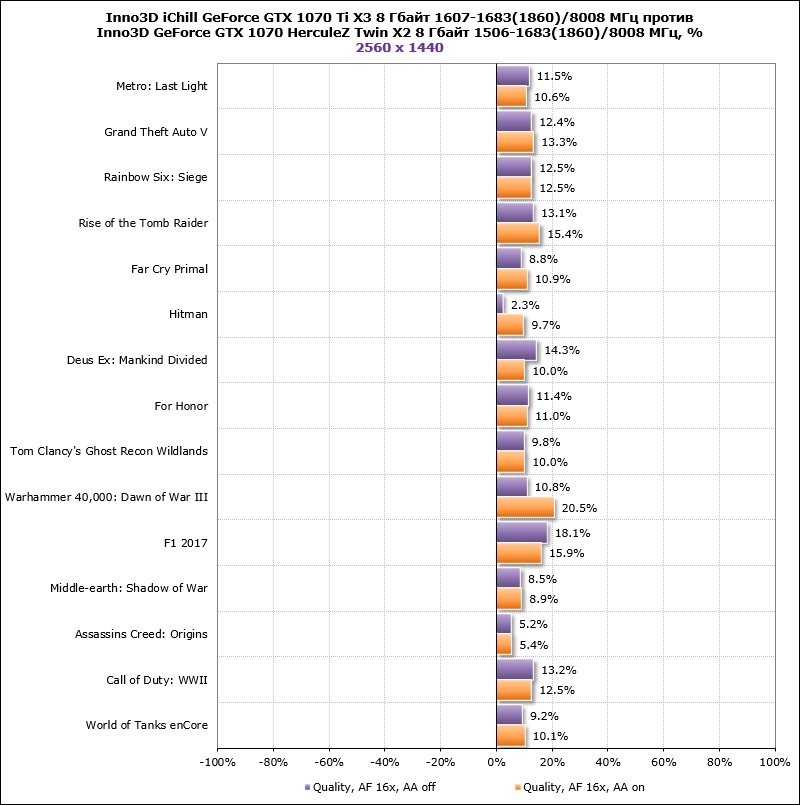
On average, the GeForce GTX 1070 Ti version outperforms the regular GTX 1070 by 10.7% without anti-aliasing and by 11.8% when enabled. Interestingly, it lags behind the Gigabyte GeForce GTX 1080 G1 Gaming by almost the same amount, although here you need to recall the factory overclocking of the Gigabyte video card. Our next pivot chart is about this comparison.
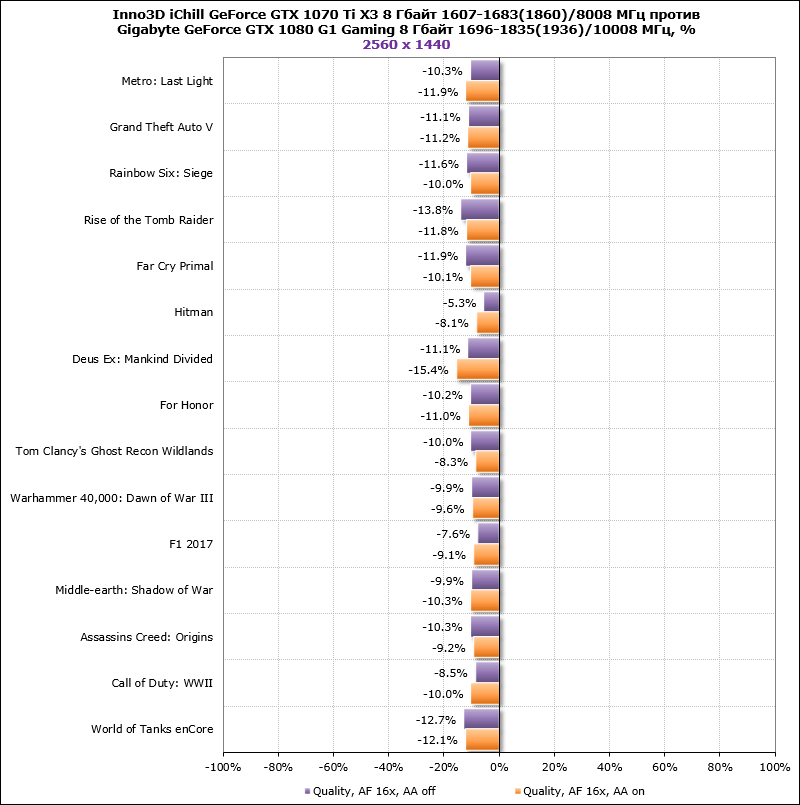
Here, the lag of Inno3D iChill GeForce GTX 1070 Ti X3 is 10.3-10.5%, which is quite a bit and can be compensated for by overclocking the video card. But first, let’s see what performance gains this very overclocking brings to it. Recall that we overclocked the GPU by 8.1%, and the video memory by 11.6%.
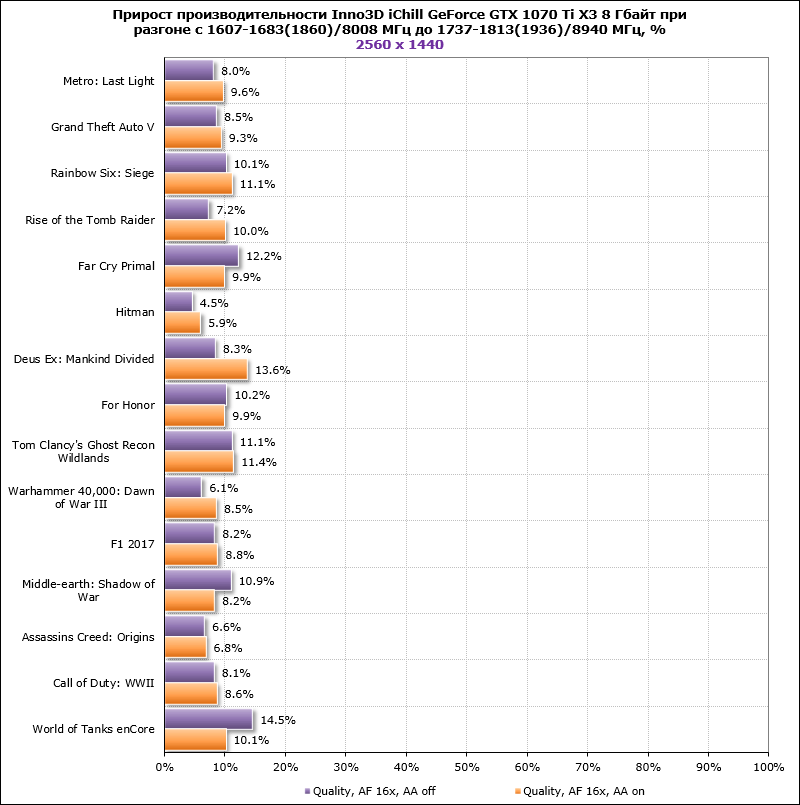
It should be noted that the acceleration is pretty good. On average, it was 9.0% without activating various anti-aliasing techniques and 9.4% with them enabled. Is that enough to catch up with Gigabyte’s original GeForce GTX 1080? We look.
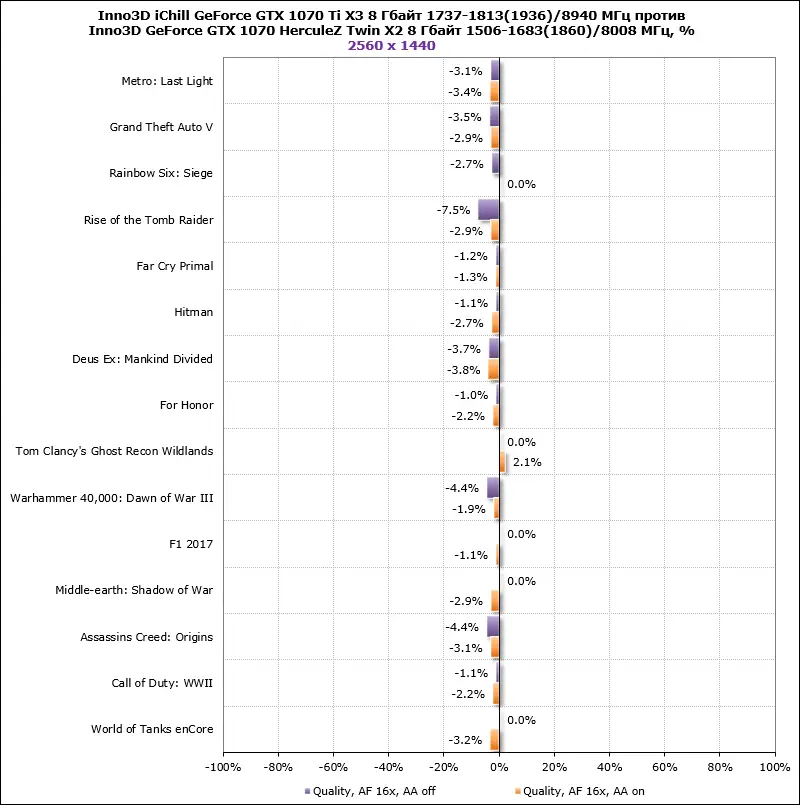
Yes, almost everywhere it was enough. In other words, it is quite possible to get a nominal GeForce GTX 1080 from the reference GeForce GTX 1070 Ti by simply increasing the frequencies of the GPU and video memory, which is extremely rare in modern model lines of NVIDIA and AMD.
Energy consumption
The energy consumption was measured using a Corsair AX1500i power supply via the Corsair Link interface and the HWiNFO64 monitoring utility version 5.73-3340. The energy consumption of the entire system as a whole was measured, excluding the monitor. Testing was carried out in 2D mode with normal work in Microsoft Word or Internet surfing, as well as in 3D mode. In the latter case, the load was created using two consecutive cycles of the Grand Theft AutoV game benchmark at 2560 × 1440 pixels at maximum graphics quality settings using MSAA 4X. CPU power saving technologies are disabled in the motherboard BIOS. Let’s compare the level of power consumption of systems with the video cards tested today according to the results in the diagram.

There were no surprises here. A system with Inno3D iChill GeForce GTX 1070 Ti X3 at its peak consumes only 12 watts more than the configuration with the Inno3D GeForce GTX 1070 HerculeZ Twin X2 and at the same time 25 watts less than the Gigabyte GeForce GTX 1080 G1 Gaming. However, when a video card is overclocked, the power consumption level in 3D mode increases by 24 watts, and the performance of systems with these video cards is leveled. Note that a 500 watt PSU will suffice for any of the tested configurations.
Conclusion
Inno3D iChill GeForce GTX 1070 Ti X3 has no serious flaws, and not serious ones either. Large dimensions, blocking 2.5 slots on the motherboard and weight? Well, in that case, she would not have the advantages that this model has. Among them are very effective cooling of the graphics processor, the ability to make a video card invisible in terms of noise level against the background of a working system unit, excellent overclocking potential, which allows it to bring its performance to the level of more expensive models that are one step higher in cost. Finally, the signal lighting of the state of the video card and the backlight of the fans, a three-year warranty, bonuses included in the package, as well as a very competitive price make Inno3D iChill GeForce GTX 1070 Ti X3 one of the leaders in its class. It remains only to find it on sale and hope for a price reduction. However, the choice, as always, is yours.
We are grateful to Inno3D for the
video card provided for testing.





